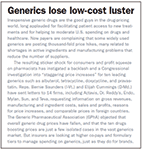Outrage Grows Over Drug Pricing
Pharmaceutical Executive
Insurers, physicians attack high-cost therapies in anticipation of specialty drug surge.
It may be time for pharmaceutical executives to devise a new rationale for drug pricing other than the need for high returns to support research and innovation. The important benefits of new cancer treatments and hepatitis cures diminish when physicians and patients find the medicines unaffordable, and Medicaid officials predict that soaring prescription drug outlays will undermine state education and safety net programs. Americans are angry that drugs cost less in Europe and object to funding biopharmaceutical development for the world. Last month's "60 Minutes" expose of soaring cancer drug prices was not a new story, but the discussion of "financial toxicity" for expensive oncology therapies clearly resonated with the public.

Jill Wechsler
Public and private payers have been willing to pay high prices for certain new drugs and orphan therapies that offer important benefits for very sick and targeted patient populations. In an analysis in the October issue of Health Affairs on the value and cost of specialty drugs, James Chambers and colleagues at the Tufts' Center for Value and Risk in Health found that specialty drugs approved by FDA from 1999 to 2011 offered greater gains in quality-adjusted life-years (QALYs) compared to traditional medicines; although specialty drugs often cost more, they offer "reasonable value for money." Another article by researchers at Prime Therapeutics supported the use of specialty drug coupons to lower patient out-of-pocket costs and support adherence, even though that strategy discourages the use of cheaper drugs and ultimately boosts costs for insurers.

Mounting opposition
But the specialty drug model was upended by approval of Gilead's Sovaldi, indicated to treat some 3 million Americans with hepatitis C virus (HCV) at $1,000 per dose. The heated debate over Gilead's pricing rationale has escalated since last month's approval of Harvoni, the company's new combination HCV pill that is even more expensive, although it could end up reducing total treatment costs. Insurers and payers see these new drugs as the tip of the iceberg for an anticipated surge in high-cost therapies for chronic conditions such as Alzheimer's and high cholesterol, which would stress health systems even more.
The attack on rising drug prices led by insurance companies has notable support from state Medicaid agencies, pharmacy benefit managers (PBMs), and consumer groups. At the annual fall Medicaid conference sponsored by America's Health Insurance Plans (AHIP), Sharon Levine of the Permanente Medical Group complained that costly specialty medicines will erode California's education system, and Michael Weinstein, president of the AIDS Healthcare Foundation, raised the specter of $10,000 pills: "If we don't draw the line somewhere," he warned, rising drug prices "will never end."
CVS Health chief medical officer Troyen Brennan noted at last month's Health Affairs briefing that pharmaceutical companies are "less than transparent" about pricing and development costs, and that Americans have a right to question whether industry's high revenues and profits reflect a reasonable rate of return.
Industry's response is continued emphasis on the value of life-saving therapies for individual patients, that prescription drugs account for a small portion of healthcare spending, and that further biomedical innovation is critical to improving health. Just after the "60 Minutes" broadcast, the Pharmaceutical Research and Manufacturers of America (PhRMA) released a report on nearly 800 cancer medicines and vaccines in development, along with an analysis of failed cancer drugs over the last 15 years to illustrate the many costly setbacks involved in discovering new treatments. And a new study from the Partnership to Improve Patient Care warns that alternative payment models, such as bundled payments, medical homes, and accountable care organizations, could diminish patient choice and impose "one-size-fits-all" cost containment tools.
Seeking new strategies
Many experts thus are looking for new ways to address these issues. Mark McClellan of the Brookings Institution proposed at the AHIP conference that "better evidence" on which drugs are more effective could support higher prices and lead to new pricing models for personalized medicines. At the Health Affairs briefing, Peter Bach of Memorial Sloan Kettering, who was featured in the "60 Minutes" report, urged a serious rethinking of coinsurance strategies and an end to Medicare Part B drug distribution, which tends to encourage physicians to administer high-cost therapies.
There's much discussion about altering how Medicare pays for drugs covered by Part D. And the Medicare Payment Advisory Commission (MedPAC) has been assessing the viability of a "least costly alternative" (LCA) approach that would align payments for certain Medicare Part B drugs administered in doctors' offices to the least expensive medicine in a class, an admittedly tricky approach, which was applied to a handful of Part B drugs between 1995 and 2010, but halted by legal action.

Generics lose low-cost luster
A recent conference on ways to "Turn the Tide Against Cancer" sponsored by the Personalized Medicine Coalition ended with a frank discussion of cost containment pressures. Stephen Eck, vice president of Astellas Pharma Global Development, described the complexities of drug pricing: that R&D costs are incurred long before a drug comes to market when it's hard to know it's full effect and value, and that current prices actually pay for the next drug development program—not the last one.
Richard Schilsky, chief medical office of the American Society of Clinical Oncology (ASCO), urged an end to all the finger-pointing between pharma and insurance companies over high co-pays and high prices. He suggested a "value pricing" approach that allows different prices for different uses of the same drug, depending on documented effectiveness for each indication. Aetna medical officer Michael Kolodziej agreed that it's probably better to examine the "global cost of care" than the "sticker price" of drugs. And CancerCare CEO Patricia Goldsmith complained that the high cost of drugs and biologics should not be the "lightening rod" in all discussions about the high cost of care.
Pharmaceutical executives might agree, but more transparency on pricing methods and unbiased assessment of the varying value of drugs is key to gaining public understanding of this complex market.

Jill Wechsler is Pharmaceutical Executive's Washington correspondent. She can be reached at jwechsler@advanstar.com.
Navigating Distrust: Pharma in the Age of Social Media
February 18th 2025Ian Baer, Founder and CEO of Sooth, discusses how the growing distrust in social media will impact industry marketing strategies and the relationships between pharmaceutical companies and the patients they aim to serve. He also explains dark social, how to combat misinformation, closing the trust gap, and more.
Is Artificial Intelligence a ‘Product’? Products Liability Implications for AI-Based Products
April 10th 2025As the physical products we use evolve to become increasingly complex, traditional products liability frameworks may not always fit to provide remedies for harm that can result from using novel product types.
FDA Approves Opdivo Plus Yervoy Regimen for MSI-H/dMMR Colorectal Cancer
April 9th 2025Approval of the Opdivo plus Yervoy combination regimen was based on results from the Phase III CheckMate-8HW trial, which was the largest immunotherapy study in patients with previously untreated, unresectable, or metastatic microsatellite instability-high or mismatch repair deficient colorectal cancer.
